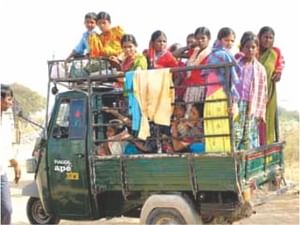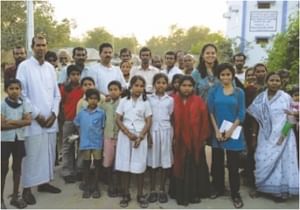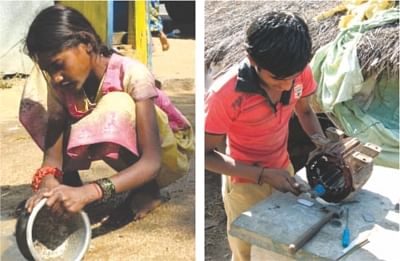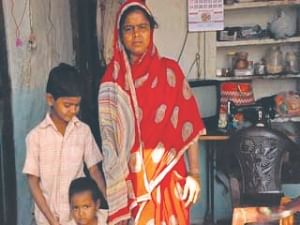| Home - Back Issues - The Team - Contact Us |
 |
| Volume 10 |Issue 45 | December 01, 2011 | |
|
|
Neighbours Forgotten People Naimul Karim
Located along the border of the Indian states of Karnataka and Andhra Pradesh, the district of Raichur has a special relationship with the people of Bangladesh. A region that is famous for its historical inscriptions, representing the various ruling dynasties, today, is home to a group of 30 thousand Bangladeshi immigrants, a large fraction of which migrated to India before the Liberation War of 1971. Although four decades have passed by, the Bangladeshi migrants, living in camps located at the Sindhanoor Taluk, still remember the exact details of their journey. “I was 18 years old when I first came to India. In the beginning we were in Agartala and from there we were sent to Raipur in Madhya Pradesh. We stayed there in camps for four years after which we were brought down here in Raichur,” says Niranjan Bairagi, an immigrant from Chittagong. Like many other migrants Bairagi and his family lost their land and property when they were forced to leave their country. “We were extremely well-off back then. My family owned a shop near Cox's Bazar and we also had an agricultural business; all that has been taken over by people living there now,” Bairagi says. Biswajit Das (Name Changed), originally from Barisal, has a similar story to narrate. According to Das, his extended family in Bangladesh was consistently threatened to give away their property. “The last time I went to Barisal, I saw people harassing my brother's family in order to take away our land,” says Das who last visited Bangladesh in 2000. Das's brother passed away soon after his visit, leaving his nephew in charge of their property. When asked if he has plans to visit his nephew, a frustrated Das says that it would be difficult for him to acquire an Indian passport and hence visiting his relatives in Bangladesh would be a risky affair. “When I applied for an Indian passport, the officials asked me where I wanted to go. My application was denied because I wanted to visit Bangladesh,” explains Das.
Although majority of the Bangladeshi immigrants living in the camps received Indian citizenships, some of them found it difficult to acquire Indian passports. “It was easier to get passports for my children since they were born and brought up here. In my case the procedure is a lot more complex since I migrated here,” explains Gita Adhikari. Thus, residents like Adhikari and Das depended upon alternative routes to visit Bangladesh. According to them, one could strike a deal with 'dalals' or officers at the Indo-Bangla border who would help them across the boundary. Explaining the process Das provided his own example, “I paid 1000 Rupees to one of the dalals who helped me cross the border and dropped me near Barisal.” He further says that the dalals and the Border Security Force had their own agreements. The large scale migration before 1970 resulted in the creation of four camps in the Taluk for Bangladeshi refugees alone. When they first arrived in Raichur, each family was provided with five acres of land, a tin house and various agricultural necessities which met their basic needs. While the facilities provided by the Indian government satisfied the Bangladeshi migrants from lower castes, migrants belonging to higher castes were unhappy. “When we were in Bangladesh, the women in my family never had to step outside to do work. Today, my own wife works in the fields,” explains Bairagi, an upper-caste migrant. “ People who had nothing in Bangladesh are leading better lives here, but people who owned hundreds of acres of land back then have found it difficult to cope,” he adds. However, according to Sujith Chakroborty, a resident from the camp, the facilities in the camps were better off as compared to the neighbouring villages. “At least 50 percent of the villagers in the camps have access to proper health and sanitation facilities, which is not the case with the other villages of this district,” he says.
While the villagers has mixed opinions with regard to the facilities provided by the Indian Government, a uniform sense of resentment has prevailed amongst them due to the high rates of unemployment in the camps. “It is difficult for us to get jobs in the public sector because we have no reservation. With the kind of education we receive, it's almost impossible for us to compete in the general category,” explains Sujith Dhali, a young resident of the village. “In Bangladesh we were under the Schedule Caste and Schedule Tribes category,” he adds. With hopes of being represented in a particular caste, a few villagers went all the way to meet officials in New Delhi, an event that led them to no avail. According to a member of the Panchayat, providing the Bangladeshi refugees with reservations was a complex affair that required the influence of higher political officials. Problems caused due to unemployment were readily visible as majority of the villagers continued to depend upon the five acres of land provided to them four decades ago. “Currently, the land that my family received in 1970 is divided amongst my sons, my nephews and my brothers,” explains Bairagi. “It'll be a huge boon for us even if one my sons can get a job,” he addes. The lack of job opportunities have also led to an increase in the rate of school dropouts in the village. “With the current standard of education, I think my children are better off working in the fields and earning some money rather than going to school,” says Adhikari. The unavailability of Bengali-medium schools also discourages parents to send their children to public schools. Having lived in a region with different cultural practices for the last forty years, one would have expected the villagers in the camps to be influenced by South Indian traditions and perhaps embrace its most basic elements. That was however not the case, as the residents of the Taluk prefer leading a Bengali lifestyle in almost every aspect. For instance, Durga Pooja and Pohela Boishak are the two main festivals celebrated within the region. Marriages mostly take place within Bengali families. If not Bengalis, the villagers preferred marrying people from Bihar, Maharashtra or Madhya Pradesh. They however, are not ready to create similar bonds with people from their very own state. “We don't connect that well with people from this region; but maybe our children will in the future,” smirk one of the villagers. Having created a new home in the camps of Sindhanoor, the Bangladeshi migrants have tried hard to start life all over again. Although not many of them would like to go back to Bangladesh, but given a chance, they'd definitely want to re-visit their roots.
Copyright
(R) thedailystar.net 2011 |



